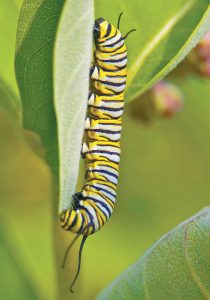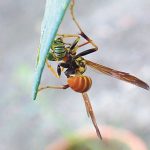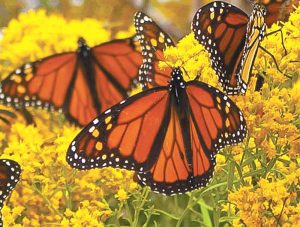August 27, 2019
Just Saying…
 By Q.C. Jones
By Q.C. Jones
Butterflies – Papillion Potpourri
For four long years, I have cultivated milk weed plants with the express purpose of attracting monarch butterflies. Patiently awaiting the reigning monarch of the butterfly clan to deem my ever-expanding milkweed patch worthy, I checked daily for the presence of the green and black striped larvae. Zero, zip, nothing, nada. No caterpillars, no cocoons and no proud coronations of high-class butterflies were to be seen.

Dare I say, patience is not one of my virtues. It might be said, virtue is not one of my virtues; I was banking on this point not being observed by winged insects. Along the way, I did everything to create a welcoming and friendly environment to monarchs. I refrained from using insecticide of any kind, allowing those nasty gnats of May to feast on my 47-acre body. I gently removed any spiders dwelling amongst my milkweed. I even switched up my path through the yard to avoid disturbing my orange winged pals to be.
 At my wits end, I began to search the internet for the secrets of the monarch’s wily ways. Armed with the latest Google-centric advice I checked my milkweed for eggs often. I crawled around the garden spot checking for eggs a couple inches from the ground. I removed known predators, risking life and limb to take care of random wasps. Still nothing. Then I discovered my friendly neighborhood butterfly expert.
At my wits end, I began to search the internet for the secrets of the monarch’s wily ways. Armed with the latest Google-centric advice I checked my milkweed for eggs often. I crawled around the garden spot checking for eggs a couple inches from the ground. I removed known predators, risking life and limb to take care of random wasps. Still nothing. Then I discovered my friendly neighborhood butterfly expert.
Allow me to introduce friend, neighbor, butterfly aficionado and denizon of Davenport’s East Side, Matt Duncan. Dare I say, Matt took me under his wing on the whole butterfly thing. Sitting on his front porch, enjoying a few of the strong spirits which call Bartonville, Kentucky home, Duncan was my guide to a world-tour of the “Danaus
plexippus” aka monarch. Allow me to share a few questions and answers.
Butterflies and moths, what’s the difference?
 There is basically little difference between butterflies and moths. They are part of the same family; the main difference comes via their main periods of activity. The French word for moth is butterfly of the night – “papillon de nuit” for Francophile Friends. And, they said those French lessons wouldn’t be worth a toot when you grew up. For some instinctive reason we humans have a disdain for things that go bump (or flitter and fly) in the night. So, with that in mind, we tend to lump moths into the same throw away category as bats, vampires and werewolves; kinda, sorta.
There is basically little difference between butterflies and moths. They are part of the same family; the main difference comes via their main periods of activity. The French word for moth is butterfly of the night – “papillon de nuit” for Francophile Friends. And, they said those French lessons wouldn’t be worth a toot when you grew up. For some instinctive reason we humans have a disdain for things that go bump (or flitter and fly) in the night. So, with that in mind, we tend to lump moths into the same throw away category as bats, vampires and werewolves; kinda, sorta.
We know about the milkweed, but what do butterflies eat?
Monarch butterflies should be divided into two categories or at least stages of life. In the case of the adult monarch, the diet consists mostly of nectar. However, not all adult butterflies eat; some have no mouth and live on stored “fat” built up during the larvae stage. The other stage is the larvae (aka caterpillar) and during that stage the monarchs are voracious eaters. It is not uncommon for a few larvae to consume most of a milkweed plant during their growth from worm to cocooned monarch in waiting.
Every type of butterfly or moth has a specific larval food source. For the monarch it’s milkweed. Others live on walnut trees, birch trees and an extensive list which even includes sunflowers. According to Matt, you can almost consider butterflies a type of parasite. Without larval host, there are no butterflies.
What about those moths who eat holes in my cowboy hats?
Yep, they too are related to the monarch butterfly – kind of distant cousins twice removed. As with the monarch, it’s not the moth who does the eating. It’s those pesky kids, I mean larvae. In the case of these critters, the larval host is the protein in woolen and silk fiber. I asked about polyester but for some reason Mr. Duncan thought I was only kidding and left briefly to gather us up another beverage.
What makes monarchs so special?
Monarch butterflies migrate. Like ducks and geese, the monarch travels much of the length of North America in search of good weather, good food and milkweed for the kids. Unlike the swallows returning to Capistrano, salmon to Petersen Creek (near Juneau AK) and the buzzards to Finley, Ohio, monarchs don’t return to their ancestral home. Newly hatched monarchs aren’t necessarily or instinctively coming back to your neighborhood next year.
Monarchs migrate but they do a generational migration. Those hatching here will most likely travel further north and lay one more set of eggs. The butterflies emerging from that hatch will live the longest and travel the furthest. This generation (which I am told is the fourth generation) will travel all the way back to Mexico before laying another batch of eggs. Then each generation from there will travel north again in the summer of 2020. When we see a monarch in July or August of next year, that will be the great-great-great grandchild of the one leaving here next week.
I thought that was amazing and I plan to tell my grandkids to bid fond farewell to the great-great grandpas (and grannys) of next years butterflies. I hope a few find my milkweed patch. Just saying…


